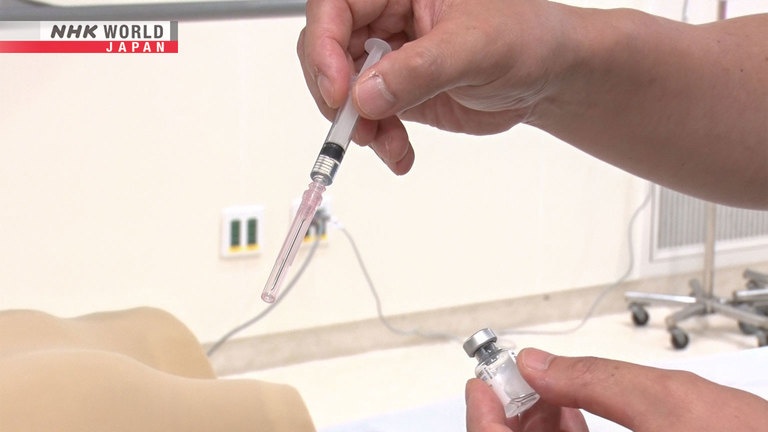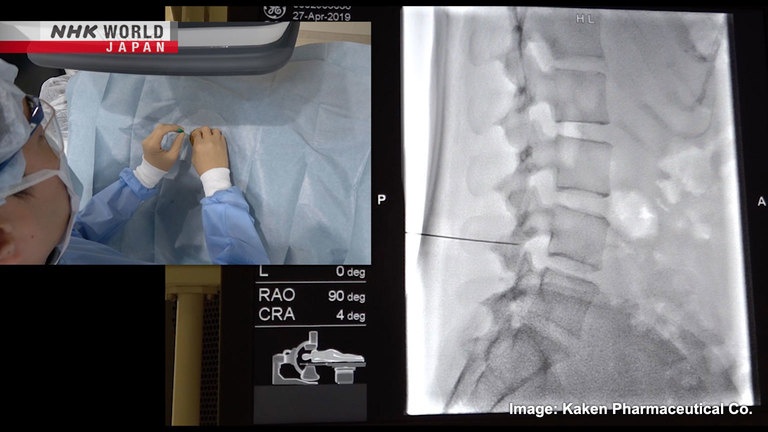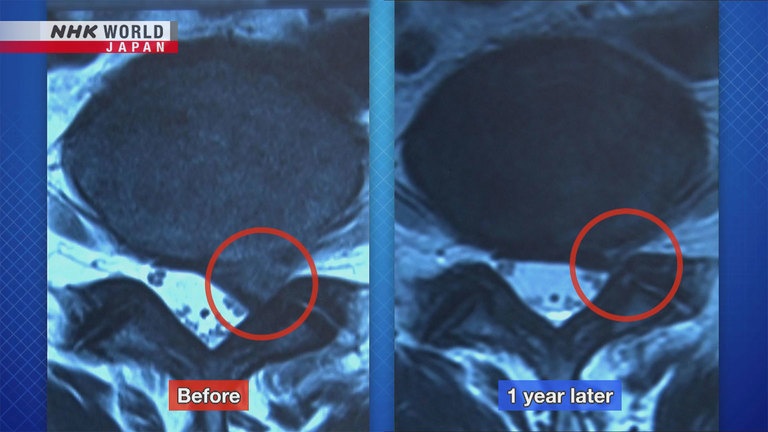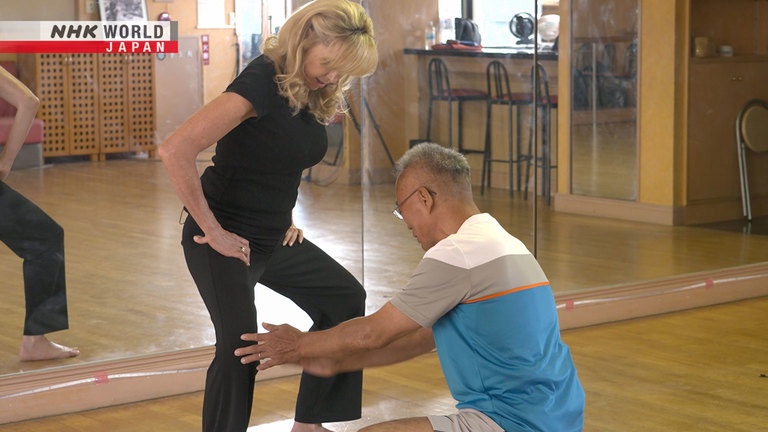Treating Lumbar Disc Hernias With a Single Shot
Lumbar disc hernias can be alleviated with conservative treatments such as painkillers in around 80% of cases, but for the remaining 20%, surgery was the only way to control the pain. However, in 2018, Japan approved a new drug, administered via a single injection, marking a breakthrough for patients seeking alternatives. The drug's development and approval in Japan took around 50 years, and it is now awaiting approval in the United States. We bring you the latest on the therapy.




Transcript
Join us as we explore Medical Frontiers.
Around 600 million people worldwide suffer from lower back pain.
While the cause in many of these cases is unclear,
some 5 to 15 percent of them are attributed to lumbar disc hernias.
Treatment options for herniated discs have been limited,
but in recent years, a promising solution has emerged in Japan.
Today, we'll be focusing on the latest treatment for herniated discs, developed in Japan.
This is the drug Japanese researchers developed for lumbar disc herniation, or LDH.
It was approved for use in Japan in 2018
and has led to improvements in over 70 percent of patients,
reducing the severity of their symptoms by more than half.
In the United States, clinical trials for the drug were completed in May 2023.
It is now expected to go through the approval process.
Kee D. Kim from the University of California, Davis took part in the trials.
He has high hopes for the drug.
I do want to caution because not all the data has been kind of analyzed,
but what I've seen so far is very promising.
I feel that it is an important new treatment option
for many of our patients who are suffering with pain from herniated disc.
I hope it will be approved for use based upon the positive results of this study.
This woman in her 50s received the drug.
Her lower back pain began six years ago.
She was diagnosed with lumbar disc herniation.
In my case, the left side of my buttocks
was particularly troublesome.
I had constant pain and muscle tightness
in the left buttock area.
I also felt heaviness, numbness
and pain in the back of my thigh.
In winter, the numbness would extend
from my calf to the tips of my toes.
When we stand or sit, our lower back is said to be subjected to a load that's 2 to 2.5 times our body weight.
This load is supported by the five bones in the lower back.
Between these bones are disc-shaped pieces of cushion-like cartilage.
They are called lumbar discs.
When these discs can't handle the strain, they may push outward.
This results in a condition known as lumbar disc herniation.
Herniated discs press against the nerves running through the spine,
causing intense pain and numbness.
This MRI image shows the lumbar discs of the woman we mentioned earlier.
One of the discs is protruding, compressing a nerve.
This image taken from above provides a clearer picture.
When nerves get compressed, they can affect
both the lower back and the legs.
It's 1 condition, but it often manifests
as 2 symptoms - lower back pain and leg pain.
Treatment for lumbar disc herniation has traditionally started with conservative methods,
including painkillers and pain-blocking injections.
After a certain period of pain control using such methods,
the hernia naturally disappears in about 80 percent of patients,
relieving compression and reducing inflammation of the nerves.
This leads to an improvement in symptoms.
But for the remaining 20 percent, surgical removal of the hernia has been the only option available to remove pain.
This can require a hospital stay and can be burdensome on patients.
The drug was developed as an alternative.
Its key ingredient is an enzyme called Condoliase.
Keio University Hospital was involved in the clinical trials in Japan.
It conducts one of the highest numbers of treatments using condoliase in the country.
Doctor Watanabe, thank you so much for your precious time today.
In terms of lumber hernias, it needs for the lumber area.
There's been no real developments or breakthroughs, has it, for the last several decades.
I'm so intrigued about how it's actually performed? How is it done?
We get the patient to lie face down, like this.
The key is to inject right into
the center of the disc.
The drug is administered in the operating room.
The doctor loads it into a syringe and carefully inserts the long needle into the patient's lower back.
There is no need for a general anesthetic.
Instead, a local one is administered.
It needs to penetrate deeply,
so we use a long needle like this one.
That's quite a long needle actually.
We inject the drug into the disc, like this.
Oh gosh you have to be incredibly precise.
This is footage of a patient receiving the drug.
Could you turn it sideways?
No, get to the front.
Before administering the drug, the doctor confirms the disc's location using X-rays.
Even as the needle is inserted and pushed deeper, he continues to check its position.
Once the needle reaches the disc, he confirms its location from all angles.
He then injects the drug.
We're done.
The procedure takes about 30 minutes.
It's less burdensome than surgery and at this hospital,
only requires one night of hospitalization to check for allergic reactions to the drug.
Definitely the skill of the skill of who is performing as well.
For spine surgeons, it's not
that difficult once they get used to it.
And Doctor Watanabe, how soon after the treatment to patients get relief, I mean is instantaneous, does it take time?
Some patients feel better in just
a few days after the injection.
Although experiencing quick relief is ideal,
we recommend waiting for about 3 months.
However, as I mentioned, some people
do see results within just a few days.
Let's look at what happens in the herniated disc when the drug is injected.
A lumbar disc has two main parts.
One is the nucleus pulposus, which is 80 percent water.
The other is the annulus fibrosus, which wraps around it.
When significant pressure is exerted on the disc, the annulus tears,
causing the nucleus to leak out and press against the nerve.
But when the drug is injected into the nucleus pulposus...
the Condoliase enzyme binds with the substance responsible for retaining water inside the nucleus.
It then begins to break down the substance.
This reduces the water content in the nucleus, causing it to shrink, and relieving the pressure on the nerve.
The woman who appeared earlier suffered for five years after her diagnosis, unable to find an effective treatment.
Finally, she learned about the drug.
The numbness and heaviness were gone
a week to 10 days after the treatment.
Unlike before, I no longer needed pain relief.
I was very surprised.
This MRI image shows her disc one year after the treatment.
Compared with its previous state, the disc that was compressing the nerve has shrunk.
She no longer has any pain and can go about her daily life and work without any worries.
A study involving 67 patients in Japan
found that symptoms improved in 76 percent after receiving the drug.
Matsumoto Morio, Keio University Hospital's director general,
has studied lumbar disc herniation for around 30 years.
He was involved in clinical trials of the new drug.
Do we know why it doesn't work in the other 20% of patients?
Condoliase is effective for herniated discs
that haven't protruded
significantly downward or upward and haven't
torn the ligaments at the back of the disc.
There are various types of lumbar disc herniations.
In some cases, the nucleus remains within the annulus.
In others, it can break through the annulus and press against the ligament.
There are also cases in which it can rupture the ligament, and so on.
The clinical studies have demonstrated that Condoliase therapy is effective
in cases where the nucleus has broken through the annulus, compressing the ligament.
So what about neck disc hernias?
Is it, is it also effective for neck hernias?
Condoliase works by shrinking discs, but
the discs in the neck are too small to benefit.
So what actually causes lumbar disc hernia?
It's not clear what causes LDH,
but genetics may play a role.
Also, jobs or sports that strain the lower back
or prolonged sitting can increase the risk.
For people sitting working at desks all day?
So is it becoming more common then?
Yes, sitting for long periods can place
a significant strain on the lower back.
Standing is considered to be less taxing
on the lumbar discs than sitting.
What's a great way to help prevent them?
It's difficult to prevent them completely, but
some postures increase the risk of LDH.
For example, bending over to lift heavy objects
puts significant stress on the discs.
Prolonged sitting in front of a computer
in a hunched position is also not recommended.
People with lower back problems should
avoid such postures whenever possible.
It's also helpful to reduce stress on the discs
by strengthening the muscles around the spine,
such as the abdominal and back muscles.
These measures can be quite beneficial.
A research team led by Matsumoto is studying ways to prevent lumbar disc degeneration.
One of its members, Suzuki Satoshi, discovered that reducing oxidative stress can avert it.
He conducted an experiment with rats that had LDH.
The images show disc annuluses in a healthy rat and one with LDH.
The annulus in the rat with LDH shows high levels of inflammatory substances
caused by oxidative stress, shown in brown.
As we breathe, we take in large amounts of oxygen,
which can become molecules called reactive oxygen species, or ROS.
These ROS can attack healthy cells and genes, leading to a condition called oxidative stress.
Researchers believe that high levels of oxidative stress
promote aging, cancer and lifestyle-related diseases.
Suzuki hypothesized that oxidative stress in the disc annulus
causes the nucleus to protrude, leading to LDH.
I assumed that oxidative stress
accumulates in degenerated discs.
It occurred to me that we may be able to curb
disc degeneration by suppressing oxidative stress.
Suzuki gave a commercially available antioxidant supplement to rats for two months.
The supplement is used in medical settings, including on bronchitis patients.
This is a nucleus pulposus of a healthy rat.
In a rat with LDH not given the supplement, the annulus was severely damaged,
and in two months, the nucleus disappeared.
But in an LDH rat that had been given the supplement, the nucleus remained.
Suzuki believes that the supplement decreased damage to the annulus and prevented the loss of the nucleus.
Lumbar disc degeneration progresses gradually.
I believe the supplement is effective when
administered before the disc is severely damaged.
The research team is conducting tests to confirm whether the supplement
can prevent the progression of lumbar disc degeneration in actual patients.
It was really interesting to see some of the research on any we see,
what other ways can we implement that can reduce this oxidative stress?
There are several lifestyle factors that can
contribute to the accumulation of ROS.
First, I believe diet is important. You should
avoid overeating, which causes weight gain.
Consuming foods rich in polyphenols, such as
vegetables and grains, can help reduce ROS.
It's important to include them in your meals.
Other factors to consider are smoking and
excessive consumption of alcohol.
These habits should be avoided as well.
What relation to smoking have in terms of healthy lumber discs?
The harmful effects of smoking on lumbar discs
are well-documented in experiments and studies.
Smoking makes it difficult for nutrients to reach
the lumbar discs and leads to their degradation.
Therefore, I strongly recommend quitting
smoking, especially for people with back issues.
The drug's origin can be traced back to the late 1960s.
It all began when a team of biological scientists at Nagoya University discovered an enzyme in soil bacteria.
This enzyme turned out to be Condoliase.
86-year-old Iwata Hisashi was a novice doctor at the time and a member of the team.
He continued to study whether this enzyme could be applied in medicine.
He conducted overnight experiments in a cold laboratory kept at 2 to 3 degrees Celsius.
The enzyme breaks down and
becomes inactive at room temperature.
That's why we had to carry out
the experiments in a cooler environment.
It felt like working inside a large refrigerator.
While conducting his research, Iwata discovered that this enzyme acts on the nucleus pulposus.
However, it took 32 years from this discovery until clinical trials began in humans.
Iwata's research was later taken over by Matsuyama Yukihiro at the Hamamatsu University School of Medicine.
Japanese clinical trials with patients, finally began in 2000.
Phase 1 and 2 in the trial's early stages included
18 patients, to whom I administered the drug.
I was convinced that it would work when
many of them reported significant improvement.
A total of 80 hospitals across Japan joined in taking part in the trials.
Doctors at these institutions cleared many hurdles to create an option
that was far less burdensome for patients than surgery.
Finally, in 2018, the drug was approved by the health ministry.
It took 50 years from the discovery of the enzyme for the drug to gain approval.
After we understood that it was effective
and tested it in humans,
that's when it got really lengthy.
It wasn't easy.
When we finally received approval, I was
so overjoyed that I couldn't stop crying.
We never gave up, believing in the benefits
the drug would bring to patients.
At first, we focused solely on analysis. Later,
we realized it could be an effective remedy.
Now, it's on the brink of spreading worldwide.
The passion of numerous doctors and researchers was the driving force
behind the creation of the new drug that requires only one injection.
In Japan's traditional sport of sumo, where two wrestlers with powerful physiques collide,
injury prevention training has been passed down through generations.
Today on the program, we're joined by an incredibly special guest.
He's a former sumo wrestler who is now managing a very famous, very popular sumo stable.
So, Mr. Masuda, thank you so much for joining us on the program today.
Nice to meet you.
During his career, Matsuda weighed around 100 kilograms,
making him one of the smaller wrestlers in a sport where the average weight is 160 kilograms.
Yet, he competed for over 20 years, retiring at 47 without any major injuries.
I heard that also sumo wrestlers, even though they have a huge amount of weight, they don't tend to get a lot of back issues.
In sumo, the lower back is crucial.
Sumo wrestlers strengthen their lower backs with an exercise called "shiko,"
which involves raising then stomping their legs.
The exercise is believed to stretch the hip joints and build core muscles.
First, let's learn how to do the "koshiwari" squat, which is essential for "shiko."
"Koshiwari" has 2 basic elements.
First, the thigh bone should be parallel to the toes.
Second, the ankle should be directly below the knee and bent at a 90-degree angle.
This ensures that they can withstand your weight.
This is too wide, right?
If your feet are pointed too inward
or too outward, you could hurt your joints.
Now, let's stand up and give it a try.
Stand with your feet a little wider than shoulder-width apart.
Tighten your hip joints and stretch upward
as if you were being pulled up from the ceiling.
Next, relax your hip joints and
lower your body as you exhale.
Stop.
Your shins aren't straight.
They're diagonal.
You're squatting too deeply.
Squat lightly, ensuring that your thigh bones and toes remain parallel,
and your ankles are bent at a 90-degree angle.
Avoid squatting too deeply at first to prevent straining your knees.
- Excessive movement may engage the outer muscles.
- It's fascinating.
The difference you can feel exactly. A lot of the core muscles are being activated and the gluteal muscles are being integrated.
Now, let's add leg-raising and stomping to the "koshiwari."
Make sure you shift your weight before lifting your leg.
Straighten the knee of your supporting leg
and put your weight on your shin bone.
Even as you shift your weight, keep your supporting knee still and straight to prevent knee strain.
Almost straightening the knee.
It feels good to stand in this position.
Oh, that's interesting, because I was bending my knee at the beginning.
It is much, much easier to do it this way.
Raise your leg as you inhale and lower it as you exhale.
Relax your whole body as you exhale.
In the beginning, it's important not to force your hips down and to do what feels natural.
I can see how if you kept doing that,
repeating it every day, you would get more and more flexible as well.
Yes. "Shiko" relaxes your body.
- Thank you for your time today.
- Thank you for having me.
I'll do it every day.